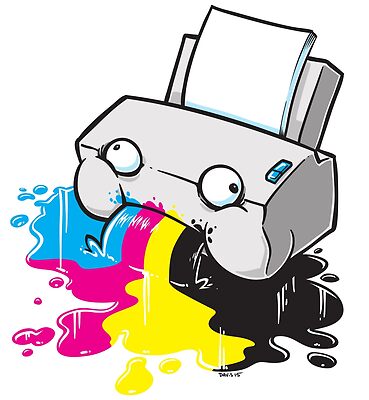How To Upload Best Quality Images To Redbubble
There are a handful of topics related to art and design that have the ability to cause even more defoliation the more you enquiry them. Your goal is simply to understand a procedure or technique better, and instead you lot end upwardly getting lost in a seemingly endless thread of comments with no more agreement than you had earlier. The topic of Image Resolution, and more specifically DPI vs PPI, is one of these ofttimes confusing subjects. So rather than dive right into the murky waters of this topic, we thought information technology would be helpful to just wade in a fleck every bit there are some expert lessons and all-time practices to learn.

"Puker Printer" by obvian
This goal when designing should always be to create high-resolution files, which refers to the sharpness and clarity of an image. However, this tin get confusing as resolution can be measured in multiple ways; Pixels Per Inch (PPI) when it comes to reckoner screens and Dots Per Inch (DPI) when information technology comes to printer resolution. DPI refers to the density of dots per inch when printing.
Every printer has a dissimilar resolution it tin can handle, and depending on the process the resolution tin can exist inverse allowing for different sizes when printing. For example, you may have heard "300 DPI" mentioned when it comes to optimal press resolutions. Well, this isn't entirely true especially when dealing with how you view images on a screen. Hopefully the below example featuring work by Madkobra, will help illustrate this. Each of the images seen below are 400×500 pixels. You will notice all iii look identical, yet the one on the left is 300DPI, eye is 72DPI, and on the right 1DPI. All three files are 400px wide and all 3 are 152kb in size.
When it comes to screen resolution, 400px wide is 400px wide no matter what the DPI/PPI is set at. This is why many have referred to worrying about DPI as pointless when it comes to sizing digital images, as what is truly important is the actual pixel dimensions. So why deal with DPI at all? Well, there are a few reasons why it'due south still expert to think about DPI/PPI. For reference, PPI is used in Photoshop and other programs and while information technology is not direct related to DPI since pixels can technically be printed at any size, PPI is still a method for targeting print size of your works, and that is worth noting here.
If you await again at the examples above, while they all take the same pixel dimensions, the PPI denotes different printing targets. The 72DPI has a target of 5.5 x half-dozen.9 inches, the 300DPI a target of 1.three ten 1.half-dozen inches, and the 1DPI a target of 400 ten 500 inches. Whoa, only that's how billboards are printed, with a actually low DPI. Depending on the viewing altitude the DPI can be lower. This is one of the reasons why it's still expert to call back about using a PPI that allows for these changes. Using a high DPI likewise allows a printer to have more room to accommodate, if you should always want you lot work printed on billboard for example.
Some other reason it's adept to recall about PPI, is that y'all don't always have exact pixel dimensions to work with. We requite you a breakdown of the pixel dimensions for each production, as recommended by the printers, which makes it much easier to deal with. However, with some projects y'all simply have a target impress size. So if yous're deputed to brand a design that is going to exist 16″ x twenty″, it's a practiced idea to aim for 300DPI only to be safe. If they only need 150DPI you can e'er adjust.
If you happen to exist given exact pixel dimensions merely likewise a target DPI/PPI, this could exist based on a recommendation of the motorcar the printer is using. There are so many dissimilar printing machines, processes, and calibrations, that information technology'due south best to take the recommendation of the printer every bit their goal is to impress your piece of work at an optimal resolution for the setup they have.
So, when creating new designs make them with as many pixels every bit possible. I also think it's a proficient idea to take a loftier resolution, 200-300DPI, and save this version every bit your master blueprint file. Keeping a master file will allow you to hands export the recommended size and resolution a printer needs. It'south always amend to scale down in size rather than upwards, specially when y'all have a target size to to piece of work with, and not verbal pixel dimensions.
We hope this helped clear the murky water a bit, and if you observe this topic interesting we encourage you to striking the web and practice some research. Simply recollect to bring some swimming gear and a flashlight.
Did you find the tutorial helpful? Please let u.s.a. know in the comments below, and share whatever tips yous might have.
(Imprint image: Rainbow Manufacturing plantby fabric8)
Source: https://blog.redbubble.com/2017/03/image-resolution-and-printing/
Posted by: deleonineaskuld.blogspot.com


0 Response to "How To Upload Best Quality Images To Redbubble"
Post a Comment